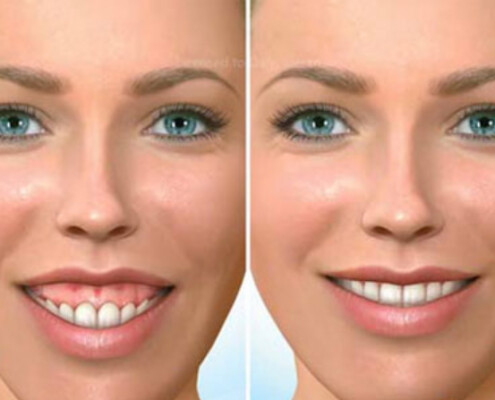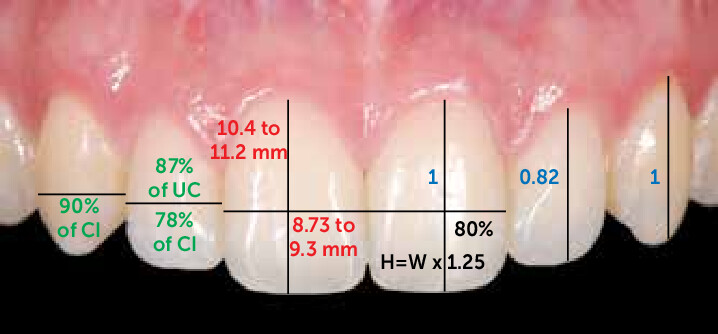
Your smile is the focal point of happiness. If you feel self-conscious about a gummy smile, you are not alone. It's a cosmetic concern that can haunt patients in their daily life.
Fortunately, gummy smiles are correctable. Enhancing the appearance of a gummy smile not only improves the aesthetics of your smile, but it can also increase self-confidence, success, and happiness.

So What is a Gummy Smile?
A gummy smile is when a person displays more gum than the ideal proportions upon a natural smile. As with anything cosmetic, a gummy smile involves both perception and aesthetics. A gummy smile does not always need to be addressed. However, when a person feels embarrassed or continually is self-conscious to smile, gummy smile correction should be explored.
So you may be wondering...What are some anatomical measurements that are typically considered as a gummy smile? Well, the ideal amount of gum showing when smiling typically is between 1mm to 3mm for adults. The gum display is measured from the top of the front teeth to the lower edge of the top lip. It is acceptable for women to show slightly more gum than men, and women typically average on the higher end of the gum display range.
It is best to consider a gummy smile in the context of the beauty and harmony of the entire face. Typically a patient feels self-conscious of their smile when the proportions of the teeth, gum tissues, lip rise, and the upper jaw are not in harmony with each other. How humans perceive the beauty of a smile in regards to gums showing is a combination of the four criteria:
-
The amount and thickness of gum tissue display
-
The size, and shape of the teeth
-
The length and the degree of the vertical rise of the upper lip upon smiling or laughing
-
The vertical position of the upper jaw and teeth in relationship to the skull
What Causes a Gummy Smile?
A gummy smile is complex because its etiology involves a variety of factors. The cause of a gummy smile may be related to genetics, orthodontic history, or environmental changes.
Genetics play a role in a gummy smile based on anatomy. There are golden rules for the proportions of the face, smile, and teeth size. As you can see in the images, the facial proportions may be analyzed when divided into thirds. When the thirds of the face are close to equal proportion, it generally tends to be more aesthetic. There are also golden proportions for lip rise and teeth size. A lip that rises a maximum of 3mm from the top of the front teeth, and when the front teeth are between 10-11mm in length is often aesthetic harmony.
Orthodontic history can also play a factor in the presentation of the smile. Often during orthodontics, it is necessary to intrude the front teeth into the gums to satisfy other ideal proportions of the overbite and occlusion. Often after orthodontics, your orthodontist may refer you for adjustment of the gums which is a normal part of the process.
The final factor that can create a gummy smile is the environment. For example, teeth can look too short if they are worn down over time, the gums can thicken from excessive clenching of the teeth, and the gums can grow excessively from certain medications such as seizure medications and some cardiac medications.


How can a Gummy Smile Make you Feel?
It’s important to understand that everyone is self-conscious at some point in their life. Absolutely everyone. For some people, a gummy smile can be an incredibly powerful insecurity.
Patients often describe their gummy smile as making them feel inadequate, or different than others. These feelings can prevent you from shining the best you can. Often patients that are self-conscious of their gummy smile have two smiles. The first is their "conscious smile." The conscious smile is the one when they smile casually. For casual smiles, they can try to control how much gum shows. The second smile is their "true happiness smile." The true happiness smile shines through when they authentically laugh with enough happiness they cannot consciously hide the gum show. Patients sometimes even try to bring their hand up to their face to block their gum display when they are caught in an authentic moment of laughter. It is heartbreaking for someone to continuously have to maintain these defense mechanisms.
If you relate to these feelings, it is important to know that the way you feel is normal, common, and it is not something to be ashamed of. You are a beautiful person with a smile to share with the world. There are options to enhance the beauty of your smile and feel the best you can.
How is a Gummy Smile Treated?
Treatment for a gummy smile is customized based on the patient's anatomy and overall facial aesthetics. Treatment can involve a number of different approaches, depending on what's causing the gum show. Some of the treatment approaches are:
-
Gingivectomy: Excess gum that is covering the tooth is removed and reshaped. This is commonly done when the teeth appear too short. Healing for a gingivectomy is minor and typically pain is mild and recovery occurs in 1 to 2 days.
-
Lip lowering reverse vestibuloplasty: A hypermobile lip is adjusted so that the lip does not rise up as high above the height of the teeth. This is typically recommended when the size and position of the teeth is normal, but the lip rises excessively due to muscle contraction when smiling. Healing from a reverse vestibuloplasty is mild to moderate pain and swelling with the majority of healing in the first 3-4 days. The success of a reverse vestibuloplasty is dependent on healing during the first month. The patient is asked to limit smiling for 3-4 weeks post-op to prevent relapse during healing.
-
Crown lengthening and Veneers: The teeth position is shifted upward by adjusting the gum and bone around the teeth and veneering the teeth in an upward position. Crown lengthening and veneers are indicated for a gummy smile when the teeth position is too low in the lower third of the facial proportions. The procedure is done in 2 phases. The first is crown lengthening which adjusts the height of the gums. Healing is typically 2-3 days of mild/moderate swelling and pain. There is a waiting period of about 6 weeks while the gum position stabilizes, and then veneers can be prepared to restore the crowns of the teeth in a new position.
-
Lefort surgery: The jaw position including the teeth is shifted upward by surgery. This procedure is required when there is severe malpositioning of the teeth and jaw structure of the lower third of the face. It is the most rarely recommended of gummy smile treatment procedures. A lefort surgery is typically performed by an oral maxillofacial surgeon in a hospital setting. Healing generally involves about 6 weeks of healing. The majority of gummy smile cases can be treated without this major surgery.


Thank You for the Kind Words From Our Wonderful Patients!